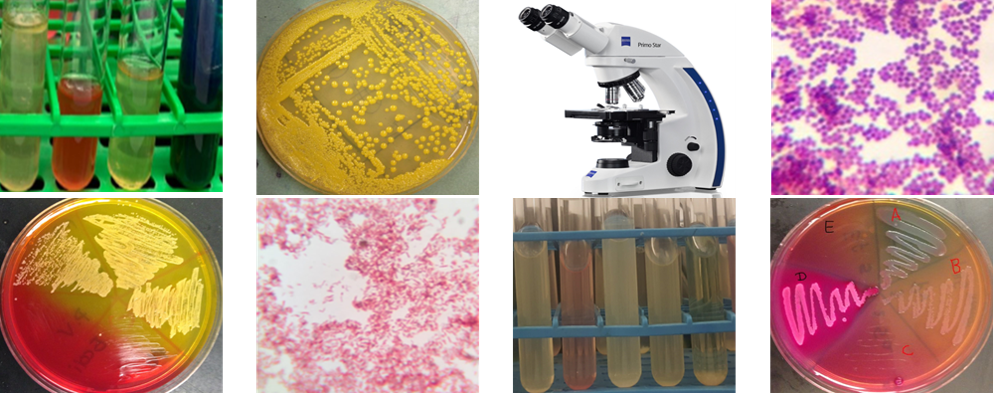Microbiology lab syllabus (PDF)
Course Description
The fundamentals of microbiology: Lectures are focused on the structure of prokaryotic and eukaryotic microorganisms, host-microbe interactions, immunity and human infectious diseases. Laboratory sessions are focused on pure culture techniques, methods of staining and the microscopic, colonial and biochemical identification of microorganisms.
Learning Outcomes
- To differentiate the major characteristics of each group of microorganisms.
- To describe the major contributions of microorganisms.
- To explain metabolism and microbial growth characteristics.
- To explain microbial host parasite relationships.
- Differentiate innate and adaptive immunity and relate the consequences of microbial invasion of these defense mechanisms.
- Develop basic microbiology laboratory techniques.
- Differentiate the various types of test used in identifying and classifying pathogenic microorganisms.
Expectations
It is expected that students MUST attend and be on time to all laboratory sessions. Being late or absence may affect your outcome. Make up tests can be given if proper documentation is provided. Additionally, a different test will be administered and points (5-10) can be deducted.
The assigned exercises and activities for each week are given in the syllabus. Students are expected to familiarize themselves with the reading material prior to lab. Labs will typically begin with Power Point presentations of the topic. Slides and other materials will be available online on Blackboard. You are responsible for downloading and making your own copies. If there are problems with downloading the online information please contact the help desk. PLEASE NOTE THAT THE POWER POINT SLIDES WILL NOT REPLACE THE ASSIGNED READINGS OR LECTURES. However, most of the material for exams will come from the power point slides and lectures.
Exams
There will be at least at least 4 tests and weekly quizzes. Exams and quizzes format will include multiple choice, short answer, fill-ins, drawings, labeling etc. The final exam will not be cumulative. Answers to every exam will be discussed. If you feel your exam was graded in error, you can request a re-grade. Tentative Exam dates, not quizzes, are also indicated on the syllabus. The final grade given to your lecture professor will be calculated as 50% of your overall course grade.
Final lab grade will be based on
- Tests 70%
- Post lab Assignments and Quizzes 10%
- 2 Lab Reports (5 + 10) 15%
- Attendance and participation 5%
Total 100%
Assignments
You are responsible for assigned exercises. For each lab topic there will be an online assignment on BB. You have two opportunities to complete each one. The higher score will be used to calculate your grade. The assignments will generally cover material discussed during lab. You will be responsible for two laboratory write ups. These will be required for the practical exams. The format will be given in subsequent sessions.
Lab Reports
You will be required to write two lab reports – one after each lab practicum. Lab reports must be follow the guidelines given. Each report must include;
- Title page
- Introduction
- Materials and Methods
- Results
- Discussion and Conclusions
- List of References
In-text citations are required and must follow APA format.
Laboratory Schedule
| EXERCISE | PAGES | |
| 1 | 1. Laboratory Safety. The use and care of the microscope. Metric system. 2. Aseptic Techniques. Inoculation and transfer techniques. Streak plate. |
3, 7, 17, 25 |
| 2 | 3. Introduction to Staining and Simple Stain.4. The Gram stain. Bacterial anatomy – discussion only. | 59 77 |
| 3 | 5. The Acid-fast stain (Ziehl-Neelsen). 6. Endospore and capsule staining. Negative staining. |
85, 91, 71, 67 |
| 4 | 7. Review of Gram Staining and Streak Plate methods. Isolation of pure culture. 8. The use of Enriched, Selective and Differential media – BA, MS, MC, PEA. |
77, 25 99, 105, 117 |
| 5 | 9. Epidemiology and related topics. Universal Precautions (discussion). 10. Practical Exam 1. |
|
| 6 | 11. Biochemical Activities – Extracellular degradation, Hydrolytic Enzymes. 12. Carbohydrate fermentation: Phenol red broth and Triple Sugar Iron (TSI) agar. |
245-257 267, 273 |
| 7 | 13. IMViC test. Multiple Test Systems: SIM, Litmus milk, 14. Urease test, Nitrate reduction test, Catalase and Oxidase test. |
285, 279 295, 301, 149, 155 |
| 8 | 15. Miniature Systems – EnteroPluri Test and API. Review of Biochemical tests. 16. Written Exam 2. The Fungi – Molds, Yeast and Mushrooms. |
231 45 |
| 9 | 17. The protozoa. 18. The effect of Temperature and pH on microorganisms. |
39, 195 |
| 10 | 19. Atmospheric Oxygen Requirements. Cultivation of Anaerobes. 20. The inhibitory action of heavy metals*. The inhibitory action of disinfectants. |
143 |
| 11 | 31. Antibiotic susceptibility testing: The antibiogram. 22. Immunology: Discussion (Antigen-antibody reactions), |
167 225, 219 |
| 10 | 19. Written Exam 3. Practical Exam 2 – Cultivation of unknowns. 24. Practical Exam 2 continues. |
143 |
| 13 | 25. Practical Exam 2 concludes. Pathogenic Microorganisms of the Skin*. 26. Microorganisms of the Mouth and Gastrointestinal Tract. |
|
| 14 | 27. Pathogenic Microorganisms of the Respiratory Tract*. 28. Pathogenic Microorganisms of the Urogenital System and STDs |
|
| 15 | 29. Helminthology. 30. Final Written Exam. |
203 |



